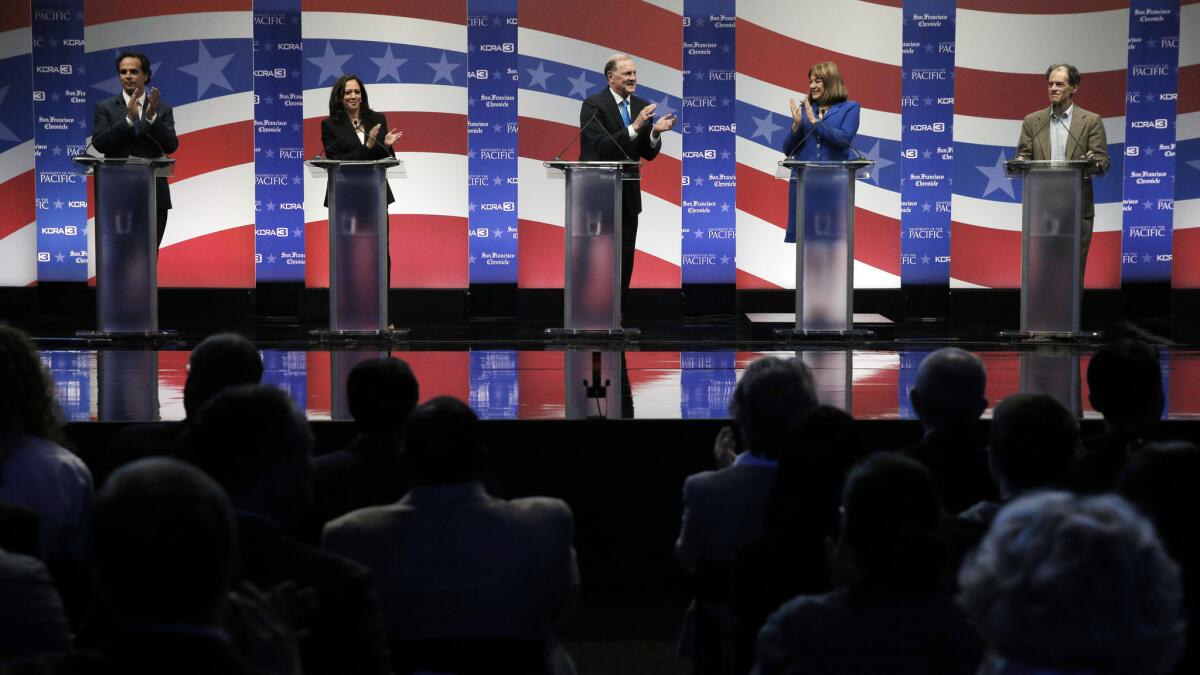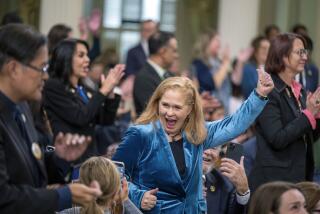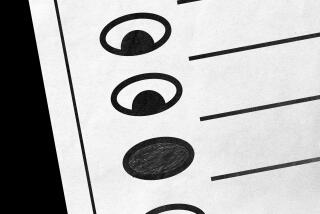Op-Ed: Top-two reform tilts California toward one-party rule

Since California’s Proposition 14 passed in 2010, all partisan candidates — except those running for president — appear on the same primary ballot, regardless of party. Then the two leading contenders face off in the general election. Like so many other electoral reforms in the state, this top-two primary system isn’t shaking out quite as intended.
Reformers promised more moderate candidates and more competitive races. Instead we’ve got something that looks like one-party rule.
The race to replace retiring U.S. Sen. Barbara Boxer is exhibit A. State Atty. Gen. Kamala Harris and U.S. Rep. Loretta Sanchez were the survivors of a free-for-all nominating contest with 34 candidates, including Democrats, Republicans and a litany of minor party and independent candidates. But in deep blue California, where Democrats outnumber Republicans by better than a 3 to 2 margin, it should be no surprise that Democrats Harris and Sanchez prevailed.
The Senate race is not the only example. Of the 53 contests for the House of Representatives, seven have candidates from the same political party. Of the 80 state assembly contests, 15 do. Of the 20 state Senate races, five do. Most, though not all, are between two Democrats. And this isn’t a fluke: The same thing happened in state elections in 2012 and 2014.
California hasn’t had a competitive race for a U.S. Senate seat since ... 1992 — and now general election voters get to choose between two liberal Democrats.
But it’s the U.S. Senate race that really rankles. California hasn’t had a competitive race for a U.S. Senate seat since Boxer and Dianne Feinstein were elected in 1992 — and now general election voters get to choose between two liberal Democrats with only nuanced differences in their policy views.
Republicans aren’t the only ones left out in the cold by this system, though.
At a time when interest in third-party candidates is at a new high, no Green, Libertarian or other alternative party will be able to oppose the Democratic duo competing for a Senate seat on Nov. 8. In fact, it has become nearly impossible for third-party candidates to gain a toehold here. Proposition 14 essentially wiped out the ability of these political parties to nominate their candidate for partisan office.
California reformers argued that the major parties were dominated by extremes on the left and the right, and that a top-two system would attract centrist candidates, especially in districts where one party was dominant. They also contended that more competitive races would increase turnout. Early studies show that neither expectation has been met.
Supporters of top-two don’t see same-party races as a problem; voters, they say, still get to choose the best person. To this line of thinking, party affiliation is meaningless.
But parties are symbols of political belief systems, with party candidates their embodiment. Voters rely on political parties as shortcuts in their election decisions. Research shows that most people identify with a political party as early as fourth grade, and most maintain that association for decades, if not their entire lives. Of course, there are independents who decline to affiliate with any political party, but most voters in California — as elsewhere — still identify as a Democrat or Republican.
Faced with two candidates from the same party, most voters are likely to be more confused than pleased. Democrats will wonder what the difference is, and Republicans will wonder if they should bother voting at all. This scenario also limits voters’ ability to produce political change by throwing their support to a different party.
Even in those races with a Democrat and a Republican on the ballot, the top-two system denies dissatisfied voters the opportunity to choose an independent or minor party candidate, which is often the mark of a protest vote expressing disgust with both major parties.
The irony here is that reformers hoped a top-two system would give the electorate more control. “Proposition 14 will change the political landscape in California,” said Gov. Arnold Schwarzenegger in 2010, “finally giving voters the power to truly hold politicians accountable.” Instead, we have a system that limits our choices to two candidates who have more in common than not.
So much for party politics in the Golden State.
Larry N. Gerston is professor emeritus of political science at San Jose State University and the author of “Not So Golden After All: The Rise and Fall of California.”
Follow the Opinion section on Twitter @latimesopinion and Facebook
More to Read
A cure for the common opinion
Get thought-provoking perspectives with our weekly newsletter.
You may occasionally receive promotional content from the Los Angeles Times.










